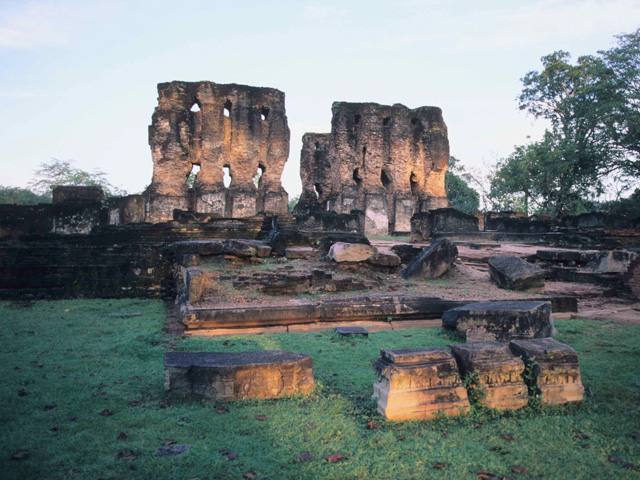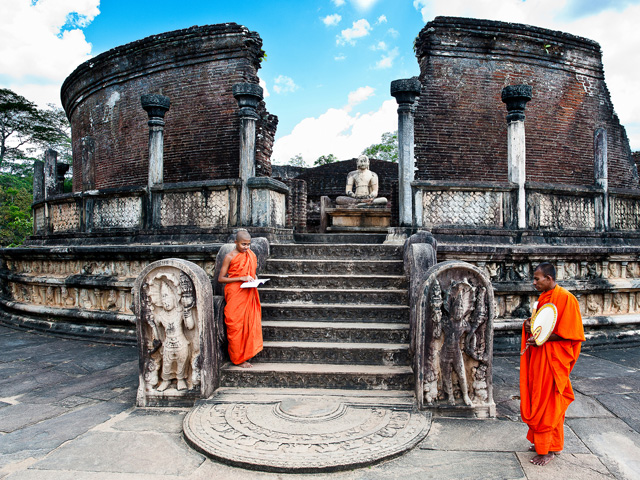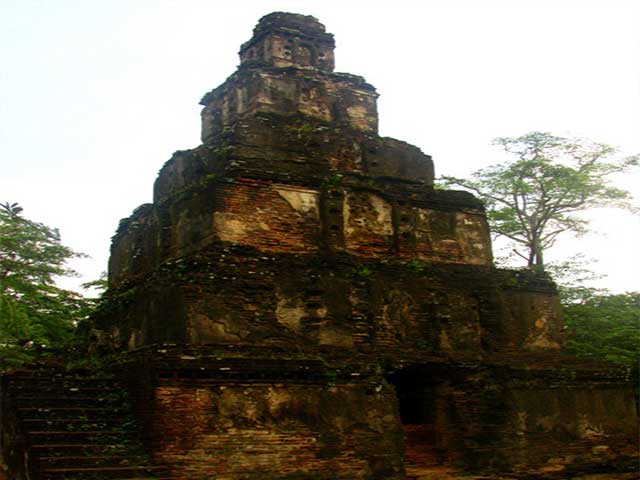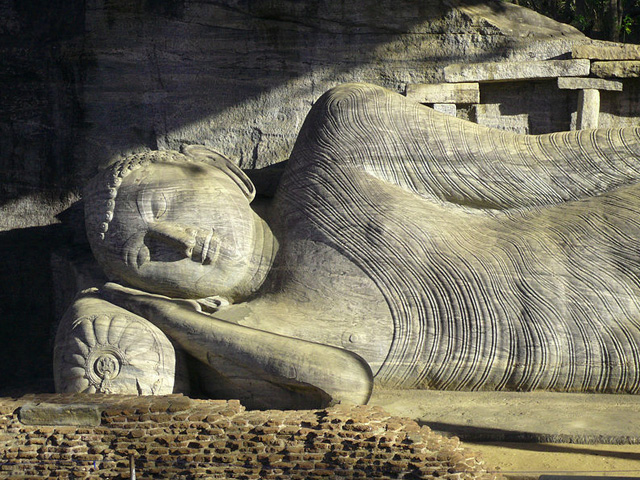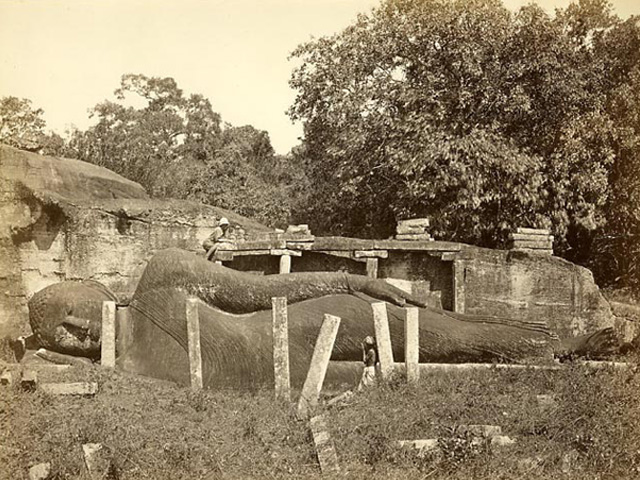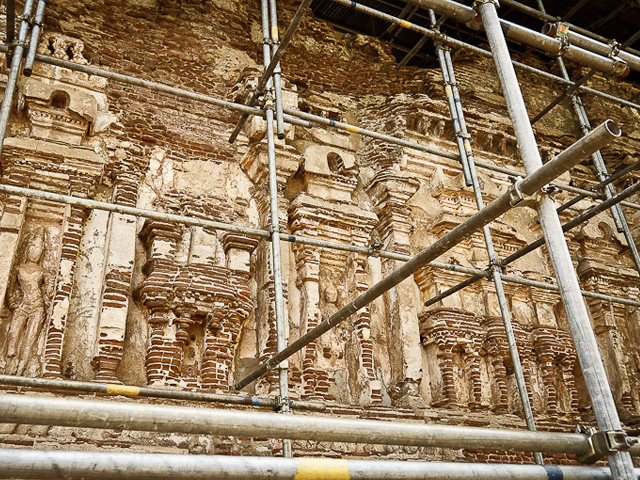Highlights of Polonnaruwa
Parakrama Samudraya in Polonnaruwa
This vast water reservoir was built by King Parakramabahu the great (1153-1186) and today what you see as the Parakrama Samudraya is only a portion of his original creation.
Parakrama Samudraya originally consisted of five large reservoirs separated by smaller dams to reduce the pressure on the main dam. They are Thopa Vawa, Eramudu Vewa (Katu Vewa), Dumbuthulu Vewa, Kalahagala Vewa and Bhu Vewa. Many smaller tanks has been built around the main tank to feed these primary tanks and to take in excess water.
Statue of King Parakramabahu in Polonnaruwa
The statue near the Potgul Vehera in Polonnaruwa, commonly known as the statue of Parakramabahu I, is a stone sculpture dating back to the Polonnaruwa period of ancient Sri Lanka. Its identity is uncertain, although the widely accepted theory is that it is a statue of Parakramabahu I. However, it has also been suggested as the statue of a sage. Carved on a large boulder, the statue depicts a majestic figure with a grave expression, holding a book or yoke in his hands.
Palace of King Parakramabahu in Polonnaruwa
This is a majestic palace build by king Parakramabahu I (1153-1186) with seven stories and said to have 1000 chambers. Although the main building possibly couldn’t hold such a number of chambers, when you consider the whole palace complex it is thought that this number is a possibility.
Today you can see the massive walls over a meter thick going up to about 30 feet (9 meters) and the bottom half of the main stairway which led to upper floors. Inside the building you can see parts of melted brick walls caused by intense heat when this was set fire by Tamil invaders at the end of Polonnaruwa era. Around the main palace there are remains of more buildings where the ministers, solders and servants lived.
Large holes in the wall probably held massive wooden structures that formed the floor of the upper levels. Even after facing such destruction by human hand and then by Mother Nature for 800 years, the plastering on these walls still remains in some places.
Potgul Vehera in Polonnaruwa
This is located some distance from the statue and thought to be a Buddhist library complex and a place where the Buddhist writings were studied and resided. The original name of this Aramaic complex is not known. This Aramaic complex is thought to be built by King Parakramabahu (1153-1186).
This brick building is built on 4 stages. On the 3rd stage there are 9 buildings which are thought to be places where the priests lived. On the very top floor there is a circular building with a dome shaped roof. The roof is no more in the building. But on the walls it is still possible to see the fragments of paintings which have survived under the forces of nature for over 800 years.
Siva Devale in Polonnaruwa
The Shiva Devalaya ( No 1) is located in Polonnaruwa old city between the Royal Palace complex and the sacred Quadrangle. The builder of this Hindu Shrine is not clearly identified. But its believed that this was constructed in 13th century AD by south Indian invaders. This was constructed according to the Pandya architectural style.
This Devalaya is build mainly with the stonework, which were done very precisely and no plastering were done to connect the stone bricks to each other. You can see the stone Shiva lingam inside, its still worshiped by the people nowadays even. At present you can’t see the roof of this Shiva Devalaya, but its believe that that was done in bricks.
Thuparama in Polonnaruwa
This image house is one of the few buildings where you can see a roof completely made out of bricks. Almost the whole buiding as survived over 900 years miraculously. The roof is a semi-cylindrical in shape. The original name of this image house is not known; therefore the builder of this is also unknown. It is thought that this was built by a minister of King Parakramabahu (1153-1186) called Mahinda to house the tooth relic. Another belief is that this was built by king Vijayabahu I (1070-1110).
The walls of this building are about 7 feet (2 meters) thick and inside a large seating Buddha statue has been kept. Nothings remain of this statue today. It is said that the eyes of this Buddha statue was embedded with precious stones and the windows were designed in such a manner the sunlight would reflect on these stones and light the image house.
Vatadage in Polonnaruwa
This beautiful Stupa House has been built before the time of Nissanga Malla (1187-1196) but he has carried out major renovations on this building. So what you see today is probably his work. Te uniqueness of such buildings is that the Stupa is protected by a roof. Therefore Stupa’s in such buildings are small.
On the centre is a small stupa and on the four sides, there are beautifully carved Buddha statues. These statues are different to what is normally found. The curly hair is not visible on the head. And the robe is also flat which is unusual. The roof has been supported by two rows of stone pillars around the Stupa. None of the pillars are visible today. But the pillars outside the walls are still intact.Four sets of beautifully carved stone stairs lead the upper level from four sides. On the side of stair case some of most beautiful guard stones and moonstones in this area can be seen. The guard stones on the eastern side of the temple is said to be the best guard stone in t he Polonnaruwa era.
Nissanka Lata Mandapaya in Polonnaruwa
This building has been built by Nissanka Malla (1187-1196). The most important feature of this building is the shape and the carvings of the stone pillars. These pillars are carved in the shape of a lotus stork and are curved in three places. The top of the pillars take form of a lotus flower. On the centre is a small Stupa. The whole building is surrounded by a fence made out of stone.
Nisshanka Latha Mandapaya is located in the Polonnaruwa Dalada Maluwa, where the Tooth Relic of Load Buddha was located in Polonnaruwa period. This the place where king Nissanka Malla used to come and listen the Pirith Chanting. Pirith is a protective Buddhist texts.
The Satmahal Prasada in Polonnaruwa
This pyramid-shaped, seven storied building is thought to be an unusually shaped stupa built during the Polonnaruwa Period (11th -13th century). It is said that similar Stupa’s can be seen in Cambodia and in Siam. It is thought this has been built for the Cambodian soldiers who were working under the king as place of worship. The building has four entrances from four sides. Also there is stair case to reach the upper levels. The person who built it, the original name of it or the purpose is still a mystery.
This is made out of brick and is over 30 feet (9 meters) in height. This structure is located inside the Dalada Maluwa of the Ancient city of Polonnaruwa.
Hatadage in Polonnaruwa
Hatadage is an ancient relic shrine in the city of Polonnaruwa, Sri Lanka. It was built by Nissanka Malla, and had been used to keep the Relic of the tooth of the Buddha. The Hatadage had been built using stone, brick and wood, although only parts of the brick and stone walls now remain. It appears to have been a two-storey structure, but the upper storey has now been destroyed. Three Buddha statues carved out of granite rock are located within a chamber of the shrine.
Gal Potha (Stone Book) in Polonnaruwa
This is one of the famous works of King Nissanka Malla (1187-1196) which describes himself, his rule and the eligibility for being a king of Sri Lanka. This massive slab which is 26’10” feet (8.2 meters) long and 4’7″ feet (1.4 meters) in breath has been brought form Mahiyangana area by the worriers of King Nissanka Malla (1187-1196). The text is written in 3 columns and contain over 4300 characters in 72 lines.
There are signs that liquidized metal has been pored on to the carved characters to bring out the letters much clearer. Beautiful carvings of two rows of geese (Hamsa) form the border of the side of the rock. Between this design at the center is a carved seated figure of Goddess Lakshmi holding two flowers and two elephants poring water on her from a container.
Pabulu Vehera in Polonnaruwa
The origin of this unusually shaped stupa is unknown but it is believed to been built by one of the king Parakramabahu’s ( 1153-1186 AD) consorts, queen Rupawathi. The original name of this stupa is not known. The current name “Pabalu” (meaning beads) was derived from the fact that a large number of small glass beads being found during the excavation of the area around the stupa. Top part of the stupa has been destroyed by invaders and centre of the stupa also has been destroyed probably by treasure hunters in the recent times.
Generally Stupa’s have only 4 image houses around it. But there are nine image houses around the stupa. These contain sitting images in some and standing images in others. One houses a “Sri Pathla” (the impression of the foot) of Buddha. Another one contains a Buddha statue in the reclining position. It is thought these image houses have been built at different time periods by different people. In addition there is a stairway to reach the first level of the stupa.
Rankot Vehera in Polonnaruwa
Rankoth ( Rankot) Vehera (Goldern Pinnacle) Stupa, is the 4th largest stupa in the country. Built by King Nissanka Malla (1187-1196), it is 55 meters in height 185 meters in circumference. This is the largest Stupa in Polonnaruwa.
Initial name of this has been “Ruwanmali dagaba” and this is a probably an attempt to build a similar Stupa to the Ruwanveli Seya of Anuradhapura. A rock inscription east to the Stupa describes how the King Nissanka Malla (1187-1196) supervised to the work of this temple sitting at that place. The guard stones at the menik vehera is also unique. Generally on the side of the guard stone you can find a carving of a bull. But on the guard stones at the entrance of the Menik vehera this bull has been replaced by an elephant.
Lankatileke in Polonnaruwa
This is a monolithic Buddha image house built by king Parakramabahu (1153-1186) lying on the South of Kiri Vehera. The building is complete made out of bricks and the outer walls are covered with elaborate designs and carvings. The Buddha statue is also completely made out of clay bricks and it has been 41 feet in height. Specially made flat bricks have been used to build this statue and today the portion above the shoulder is destroyed.
At the entrance to the building is two massive pillars made from bricks. The tallest one is 58 feet in height. It is thought that these pillars would have been at least twice as tall this before destruction . According to chronicles this building has had five stories.
Kiri Vehera in Polonnaruwa
This large stupa, lying north of Lankathilaka Pilima Ge is said to be built by a queen of king Parakramabahu (1153-1186) called “Subadra”. The original name of this has been “Rupavathi Stupa”. This stupa is also the second biggest stupa in Polonnaruwa today. Also it is the only stupa to survive the 900 years of forces of nature and still is in the original condition.
There are many restored smaller stupas around Kiri Vehera. These have been identified as burial chambers of high priests and royals. Many of these including Kiri Vehera stupa has been attacked by treasure hunters and their valuables looted.
Gal Vihare in Polonnaruwa
This magnificent group of statues was built by king Parakramabahu (1153-1186) which was part of the Uthararama Complex. The first statute you will come across is a seated Buddha in meditation. He is seated on a lotus. The rock behind the statue is decorated with carvings of “vimana”. Four smaller Buddha statues can be seen on these decorations.
Next is a smaller statue of Buddha (about 15 feet high) carved in to the rock. On the sides of the statue are two deities. It is believed this carving represent the Buddhas visit to heaven called “Thusitha” to preach to his mother. It is said that this statue was painted with pure gold and treasure hunters have burnt logs on the statue and melted the gold.
Third is a standing statue of Buddha. This has been disputed by some and think this is the statue of Ananda thero at the site of lord Buddha’s passing away. This 23 feet tall statue is thought to be done by a later king as the chronicles talk about only two statues in the seating position and one statue on the lying position which was done by King Parakramabahu (1153-1186).
Next and the last is a massive statue of Buddha passing way. This is 80 feet long. The ear lid falling along the body, One foot slightly behind the other (The toes are not positioned equally on the feet) are signs that this is not Lord Buddha resting but at his death.
Lotus Bath or Nelum Pokuna in Polonnaruwa
The Pokuna or the baths found at Polonnaruwa are comparatively of modest dimensions. The architecturally perfect Kumara pokuna found close to King Parakramabahu’s palace, the pokuna found near the rest house and believed to be that of King Nissanka malla, the austere baths of the Alahana pirivena are some examples.
Yet a jewel of the pokuna architecture lies hidden along the lonely road to the northern city, well away from the bus loads of pilgrims and tourists that crowd Polonnaruwa’s more famous quadrangle packed with ruins from different dynasties differing in architecture and style.
Tivanka Image House in Polonnaruwa
Tucked away under huge shade trees, a pleasing dive away from the main cluster of Pollonnaruwa’s ruins is the Thivanka pilimage identified as the image house of the Jetavanarama built by king Parakramabahu.
Here at the Thivanka Pilimage we are treated to a sample of ancient classical art and the delightful sculpture of Polonnaruwa era. From outside the walls of the building are festooned with a profusion of decorative sculpture. Half way up on the wall a procession of jolly figurines of gana or dwarf figures are seen bursting with the full joy of life. Their merriment. their passion. and sensuality is overwhelming.










